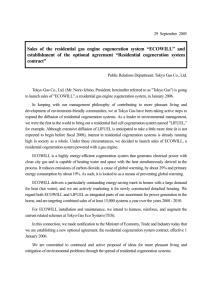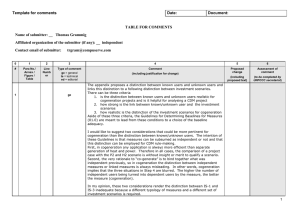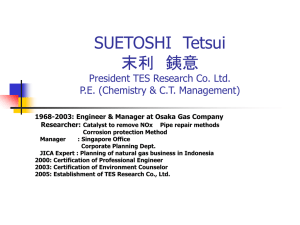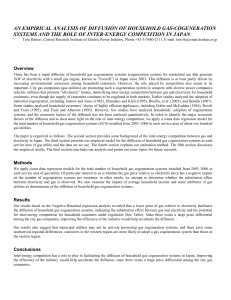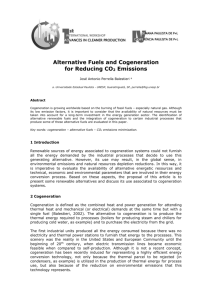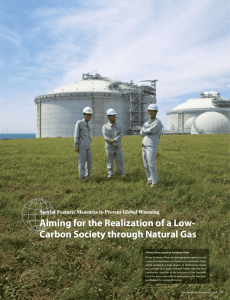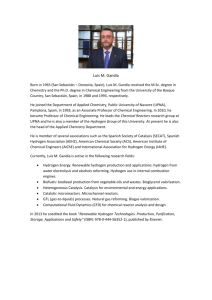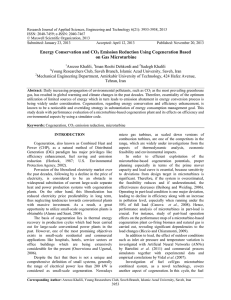Osaka Gas Group Technology Management
advertisement
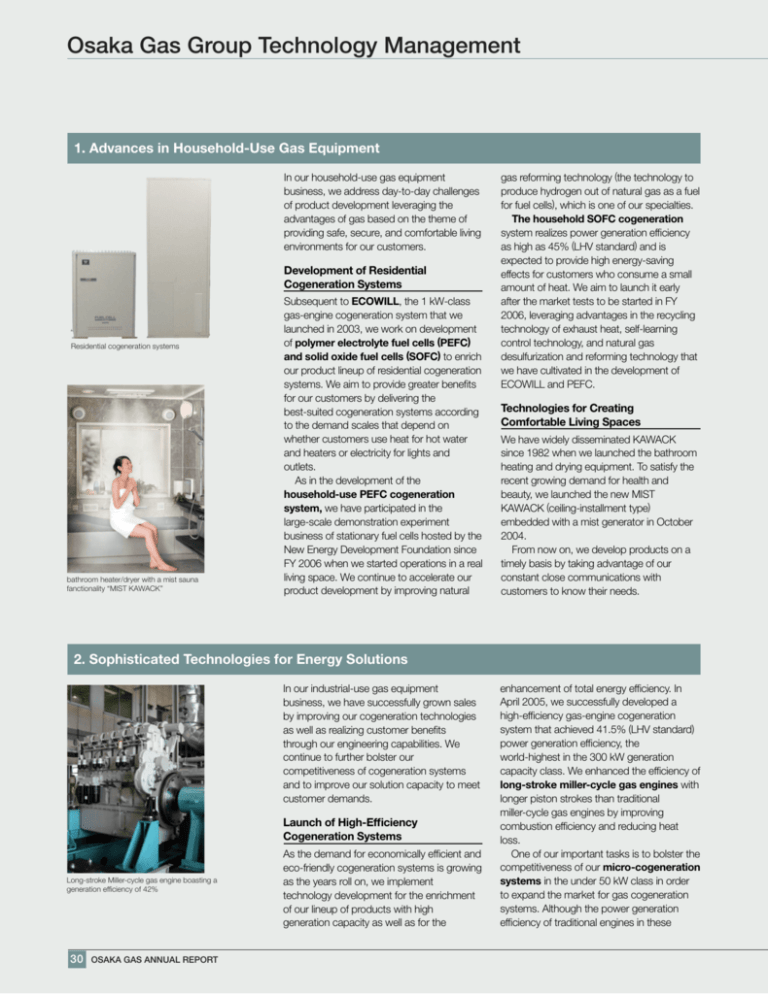
Osaka Gas Group Technology Management 1. Advances in Household-Use Gas Equipment In our household-use gas equipment business, we address day-to-day challenges of product development leveraging the advantages of gas based on the theme of providing safe, secure, and comfortable living environments for our customers. Development of Residential Cogeneration Systems Residential cogeneration systems bathroom heater/dryer with a mist sauna fanctionality “MIST KAWACK” Subsequent to ECOWILL, the 1 kW-class gas-engine cogeneration system that we launched in 2003, we work on development of polymer electrolyte fuel cells (PEFC) and solid oxide fuel cells (SOFC) to enrich our product lineup of residential cogeneration systems. We aim to provide greater benefits for our customers by delivering the best-suited cogeneration systems according to the demand scales that depend on whether customers use heat for hot water and heaters or electricity for lights and outlets. As in the development of the household-use PEFC cogeneration system, we have participated in the large-scale demonstration experiment business of stationary fuel cells hosted by the New Energy Development Foundation since FY 2006 when we started operations in a real living space. We continue to accelerate our product development by improving natural gas reforming technology (the technology to produce hydrogen out of natural gas as a fuel for fuel cells), which is one of our specialties. The household SOFC cogeneration system realizes power generation efficiency as high as 45% (LHV standard) and is expected to provide high energy-saving effects for customers who consume a small amount of heat. We aim to launch it early after the market tests to be started in FY 2006, leveraging advantages in the recycling technology of exhaust heat, self-learning control technology, and natural gas desulfurization and reforming technology that we have cultivated in the development of ECOWILL and PEFC. Technologies for Creating Comfortable Living Spaces We have widely disseminated KAWACK since 1982 when we launched the bathroom heating and drying equipment. To satisfy the recent growing demand for health and beauty, we launched the new MIST KAWACK (ceiling-installment type) embedded with a mist generator in October 2004. From now on, we develop products on a timely basis by taking advantage of our constant close communications with customers to know their needs. 2. Sophisticated Technologies for Energy Solutions In our industrial-use gas equipment business, we have successfully grown sales by improving our cogeneration technologies as well as realizing customer benefits through our engineering capabilities. We continue to further bolster our competitiveness of cogeneration systems and to improve our solution capacity to meet customer demands. Launch of High-Efficiency Cogeneration Systems Long-stroke Miller-cycle gas engine boasting a generation efficiency of 42% 30 OSAKA GAS ANNUAL REPORT As the demand for economically efficient and eco-friendly cogeneration systems is growing as the years roll on, we implement technology development for the enrichment of our lineup of products with high generation capacity as well as for the enhancement of total energy efficiency. In April 2005, we successfully developed a high-efficiency gas-engine cogeneration system that achieved 41.5% (LHV standard) power generation efficiency, the world-highest in the 300 kW generation capacity class. We enhanced the efficiency of long-stroke miller-cycle gas engines with longer piston strokes than traditional miller-cycle gas engines by improving combustion efficiency and reducing heat loss. One of our important tasks is to bolster the competitiveness of our micro-cogeneration systems in the under 50 kW class in order to expand the market for gas cogeneration systems. Although the power generation efficiency of traditional engines in these classes remained between 20% and 30%, we achieved 33% (LHV standard) power generation efficiency, the world’s highest in the 25 kW generation capacity class, owing to the application of the miller-cycle combustion technologies that we cultivated in the development of large engines and to the enhancement of conversion efficiency of power generation machines and inverters. We intend to expand the market to small-scale business such as restaurants and public bathhouses by development of these engines. Combustion Technologies Exploring the Heat Market By leveraging the combustion technologies that we have accumulated mainly in the development of industrial-use burners, we continue to explore the market for industrial-use heat. For melting furnaces of non-ferrous metals such as aluminum, we developed regenerative burners with high energy-saving effects embedded with thermal-storage mediums. The sales of the energy-saving type furnace for non-ferrous metals ECOMELTER are now steadily growing. energy-saving type furnace for non-ferrous metals “ECOMELTER” 3. Technologies as the Backbone of the Safety and Comfort of Gas (Stable Supply, Safety, and Security) Evolution of Safety Technologies We strive to ensure security by a daily patrol of all the routes of high-pressure gas transmission pipelines which are the essential part of natural gas supply. The main purpose of the daily patrol is to prevent damage to high-pressure pipes from road excavations by third parties for which construction has not been acknowledged. By use of mobile phones and GPS locators, we started to operate the high-pressure pipeline patrol support system, which indicates the areas of acknowledged construction work by other parties and the current position on an electronic map, in order to discover unacknowledged construction work. We intend to improve the quality of our daily patrol and maintain the uninterrupted supply of gas by using this system. Sophisticated Safety Functions of Gas Equipment We successfully developed the Class-S Premier, a more convenient, advanced, and safer gas stove than ever before, as the top-class product for glass-top built-in gas stoves with a top board made of heat-resistant ceramic glass. A burn-without-pan sensing function is built in the frequently-used left and right burners. This function was developed for the first time in the industry. The over-heating prevention system for cooking deep-fried food, which has been built into only one burner before, is equipped for all the burners for safer cooking. To PIKO PIKO, a gas alarm system that senses gas concentration in the room caused by gas leaks and incomplete combustion in an emergency, we added a high-level self-checking function that issues a warning to customers about any problems in the gas alarm system itself. This is so our customers can use gas more safely. Class-S Premier 4. Technologies to Discover New Business From Carbon Materials to Photon and Electronic Materials Since the days of gas manufaccturing from coal, we have actively expanded our business with a focus on carbon material technologies and in other areas of activated carbon, electrode materials, and fine materials. In March 2005, we acquired the stock of Japan EnviroChemicals, Ltd., engaged in living environments business such as production of activated carbon powder. We aim to expand our business by taking advantage of the synergy effects that are generated from the collaboration between the acquired company and Osaka Gas Chemicals Co., Ltd., involved in the production and sales of activated carbon fibers. In our photon and electronic materials business, we have focused our attention on the fluorene contained in coal tar and Lenses (Same as the one in the previous year’s annual report) OSAKA GAS ANNUAL REPORT 31 Osaka Gas Group Technology Management HYSERVE hydrogen production unit using city gas reforming technology developed an industrial method for producing dozens of fluorene conductors and marketing them as materials. The features of fluorene conductors, high refraction rates and heat resistance, are highly valued to push up sales mainly for lenses of camera-equipped mobile phones and liquid-crystal-related materials. Consequently, sales amounted to about 2.7 billion yen (up 35% on a year-on-year basis) in FY 2005. Hydrogen Production Technologies For hydrogen stations for industrial use and fuel-cell vehicles, we produce the compact hydrogen production unit HYSERVE using natural gas reforming technologies. The hydrogen production capacity of our product lineup ranges from 30 Nm3/h to 100 Nm3/h. By leveraging natural gas reforming technologies as one of our specialties, we reduced the reforming cost and the size to the half that of our traditional type. The first model of 100 Nm3/h was installed for the hydrogen station at the Exposition of Global Harmony in March 2005 in Aichi. 5. For Early Outcomes of Technologies (Our Thorough Technology Management) We have invested our resources strategically in technology development, positioning it as the most effective differentiator to bolster our technological competitiveness. As the early outcomes of technology development are expected more under circumstances where customer needs turn constantly and competitive climates change rapidly, we intend to complete thorough technology management to satisfy such demands. (1) Chain of Technology Development Results We have shifted materials for natural gas from coal to petroleum oil and natural gas. The technologies that we cultivated in the use of the respective materials are accumulated and utilized as the core technologies inherited from age to age. Carbon materials technologies originating in tar as a secondary product of coal gas Catalyst technologies in the age of producing gas from petroleum oil Cogeneration technologies to optimize the use of energies in the age of natural gas We select themes of technology development from the viewpoint of whether we could solve the issues by 32 OSAKA GAS ANNUAL REPORT utilizing our core technologies or not after we fully understand the important technology issues for the development theme. We continue to explore the potential of new product development using our core technologies with the aim of creating a chain of technology development results based on the advancement of core technologies. For example, the natural gas reforming technologies, in which catalyst technologies are maximized, are utilized in the theme of technology development of the compact hydrogen production unit and the residential PEFC cogeneration system. (2) Reduction of Development Lead Time and Thorough Market Orientation by Reinforcement of External and Internal Collaboration We endeavor to reduce our development lead time by the synergy effects generated through an active alliance with partners with the technologies or intellectual property rights that we do not own. We jointly develop the SOFC cogeneration system with an advanced fuel cell stack manufacturer by leveraging our reforming technology for extracting hydrogen out of natural gas as well as our exhaust heat recovery technology. To consistently promote technology development in consideration of market needs, each division in charge of household and industrial customers adopts a sponsorship system to relegate development themes to the Technology Division at our headquarters where technical skills are accumulated. Our divisions reflect constantly changing customer needs to our technology development promptly and flexibly, while the Technology Division controls our development policies based on visible needs as the occasion arises.

